Intel Details Manufacturing through 2023: 7nm, 7+, 7++, with Next Gen Packaging
by Ian Cutress & Anton Shilov on May 8, 2019 4:35 PM ESTAt Intel's Investor Day today, CEO Bob Swan and Murthy Renduchintala spoke to the ability of the company with respect to its manufacturing capabilities. Intel has historically been strong in its ability to execute on its process technology, however the delay of its 10nm process has obviously raised multiple question marks, and has done for several years. The two Intel executives went into a little detail about what Intel was doing in the interim, and how it has learned from the issues.
Back in 2013, Intel envisoned its 10nm to succeed the 14nm by providing 2.7x density, with new technologies such as Self-Aligned Quad Patterning (SAQP), Contact over Active Gate (COAG), Cobolt Interconnects, and new packaging technologies such as EMIB and Foveros. Intel admits that this was an ambitious plan, and the goals were not clearly defined with the teams and it was ultimately overly complex and not managed in an ideal way.
This ended up pushing 10nm out into a later time frame. In this case, Intel pushed 10nm out to 2019 (technically they shipped Cannon Lake in small quantities on 10nm in 2017, however that is nothing more than a curio in the timeline of semiconductors), and filled the gap with 14+ and 14++.
Intels 14+ and 14++ processes extracted more than 20% more performance (from Broadwell to Whiskey Lake) from the process since its inception. As a result, Intel is prepared to not only get ready for future intra-node optimizations, but actually adjust the roadmap to compensate for it. Murthy made it clear that Intel wants to introduce a Moore's Law-like gain at the beginning of a new process, and another similar gain by the end of the process.
Intel has stated that its 10nm product family (beyond Cannon Lake) will start to be available from the middle of this year (2019), with Ice Lake on client platforms (notebooks).
Intel will be launching multiple 10nm products through 2019 and 2020, including server based 10nm in the first half of 2020:
In the above slide, Intel states that it will have 7nm in production and launching a product in 2021. That sounds very aggressive for a company that has had issues with 10nm. It even shows in Intels radmap, with 10nm (and 10+ and 10++) having a much shorter life cycle than the 14nm family of processes.
With this in mind, Intel's 7nm is going to be the combination of what Intel has learned from the 14nm and 10nm family of products. Intel wants that 2x scaling (Moores Law), but with intra-node optimations planned as part of the roadmap. Intel is also reducing its number of design rules, which should help with execution. 7nm will also be where Intel intersects with EUV, and also introduce next-gen Foveros and EMIB packainging.
Intel provided this slide, which shows a monolithic PC-Centric die with a multi-die Data-Centric chip built on both Foveros and EMIB. This corroborates our discussion with Intel's chiplet and packaging team, who also stated that we would see Foveros and EMIB on a combined product - specifically the GPU.
Intel announced that its lead 7nm product (lead = top, or lead = first?) would be its new GPGPU, built on the Xe graphics architecture. Intel has stated that its Xe product stack will feature two different microarchitectures from mobile client up to GPGPU, with one of those architectures called Arctic Sound - technically Intel will launch its first discrete GPU in 2020 according to its press release, however the 7nm GPGPU will be launched in 2021.
More information is coming out of Intel's Event, more to follow.
Related Reading
- Intel: EUV-Enabled 7nm Process Tech is on Track
- Intel Starts Qualification of Ice Lake CPUs, Raises 10nm Volume Expectation for 2019
- Intel Agilex: 10nm FPGAs with PCIe 5.0, DDR5, and CXL
- Intel to Equip Fab 42 for 7 nm
- Intel Discloses Plans to Spend $5 Billion on Fab 28 Expansion in Israel
- Intel Submits Ireland Fab Expansion Plan: $8 Billion Price Tag, With a 4 Year Lead Time
- Intel Details Plans for Its Oregon Fab Expansion: D1X Phase 3
- Intel to Expand Production Capacities at Multiple Fabs
Source: Intel


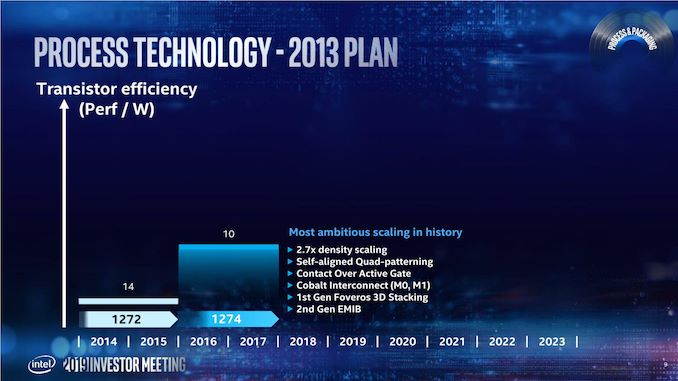

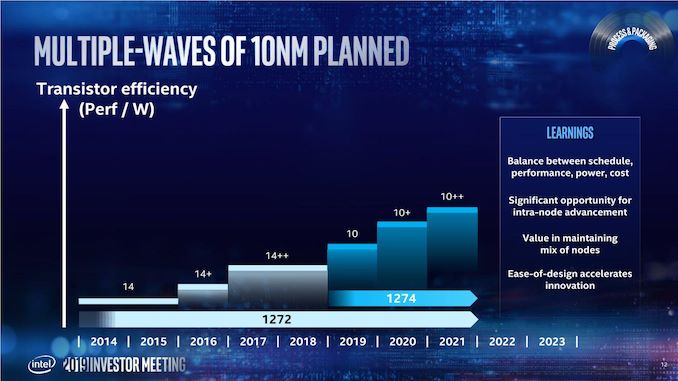
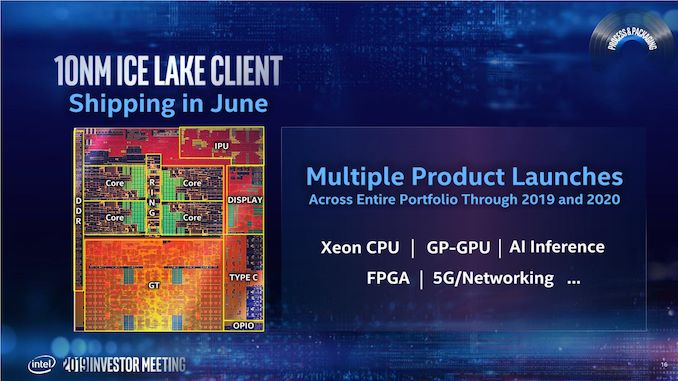
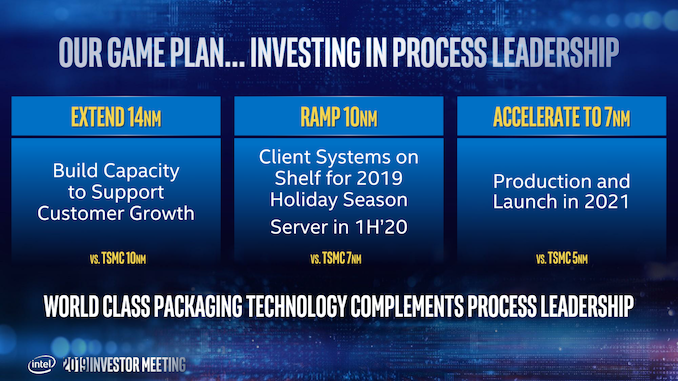
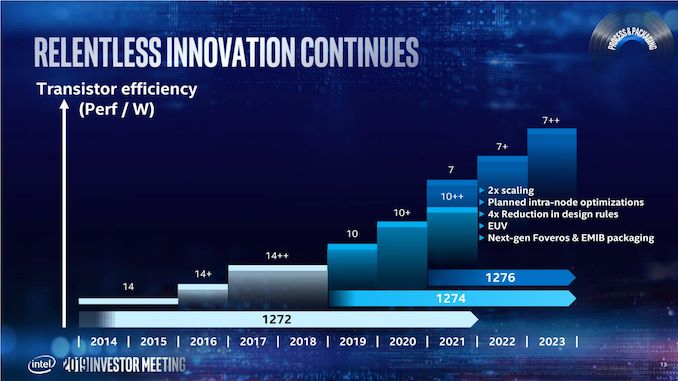

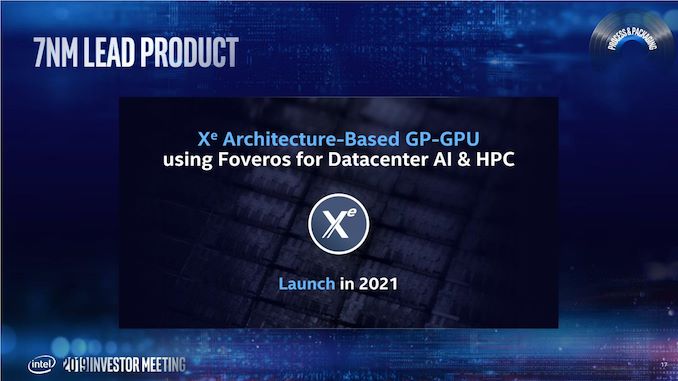








237 Comments
View All Comments
Xyler94 - Friday, May 10, 2019 - link
You fell for Intel's reasoning to keep giving us 4 cores on Mainstream for so long.What downside is there to an efficient 16 core processor on the Mainstream high-end? If it does extremely well in gaming, it's just pure power. It's like saying you'd rather a Mazda 3 instead of a Ford GT in a track race, because you're not a racing enthusiast.
More power to us is never a bad thing, why are you trying to complain that AMD is trying to give us more for less money? That is the dumbest thing I can imagine someone saying. "Oh, I'm okay with what we got now, don't innovate and give us something more, please. It's not needed for my specific use case"
Targon - Friday, May 10, 2019 - link
You really don't see it, but there are a LOT of processes that run in the background, and as time goes on, there are going to be more. You have multiple web pages open in different tabs, plus this and that, and suddenly, things feel sluggish when switching between running programs. Four cores is enough for NOW, but then again, dual-core should have been dead six years ago due to how much is going on behind the scenes.For those who build their own systems, we tend to be enthusiasts, not just those playing games, but those actually doing a LOT on their computers. Four cores feels sluggish to me at this point compared to 8 cores@3.8GHz, and I'm not gaming on my computer all that much.
Targon - Friday, May 10, 2019 - link
You don't care much about AMD stuff....considering that AMD will be using a more advanced fab process than Intel for at least the next three years, and that AMD is about to release a full line of chips that will beat Intel in IPC and "core for core", plus offer more cores on top of that SHOULD make you wake up to what is going on.All this talk about future hopes and dreams for Intel, when AMD will have the new generation going out in the next two months SHOULD make people stop waiting for Intel to actually follow through on their promises of 10nm.
AshlayW - Thursday, May 9, 2019 - link
"It will be soon time for AMD to play catchup - Sunny Cove is going kick AMD off the map. I expect that and time will show it will do so."Oh dear. Sunny Cove is likely 5-10% higher IPC than Skylake, realistically. Zen2 is likely 5-10% higher IPC than Zen1, realistically. I'm being very modest to keep expectations in check. In reality: Sunny Cove is going to be % faster IPC than Zen2 that Skylake is over Zen1, right now.
Did Skylake 'kick AMD Off the map' ? Nah. Zen1 and now Zen+ are really hurting Intel's bottom line. Intel has a small IPC advantage and similar perf/watt using a vastly better process (14nm+++ >>>> GF 12nmLP) and they're still losing marketshare. Unless Intel can learn to price its products fairly, and actually offer innovation in the Desktop PC space, they're going to keep losing share, even with this fancy new architecture.
Ryzen is outselling Intel Core by a fairly significant amount, and companies are going to make the switch to Rome in the coming months, as no one wants that 400W Intel turd.
Nimrael - Thursday, May 9, 2019 - link
Zen 2 IPC's improvement will be of SIMD FP FPU's...While the sunny cove will have a L1 caches inreased. Prior to post some fantard "analytics', better get familiar with the facts.
HStewart - Thursday, May 9, 2019 - link
Keep in mind you only seeing Ryzen on desktops and not in mobile space. I would also say from personal experience a my 8th gen quad core I7 is about 20 to 50 % faster than my 4th gen quad corewhich is actually before Skylake.
I never mention Skylake knock AMD off map - but I believe Sunny Cove will give AMD some trouble.
I not Intel, but if I was in there current situation, I would come back with a product that will never question their performance again. And make this process discussion obsolete. Also make desktop processors not an issues - mean there is no difference between desktop and mobile CPU's - that high end desktop can be place in laptop without issue. If 10nm power requirements are done right than it does not matter anymore.
Just remember Intel has been hard by AMD and know and don't be foolish to believe that when new products come out that that it going to be like the Cannon Lake product - this is different product coming in june.
Korguz - Thursday, May 9, 2019 - link
of course it is.. because of the minor improvements to IPC intel has done between the 4th gen and 8th gen... i can say the same between my 1st gen I7 930, and my current I7 5930k ..." mean there is no difference between desktop and mobile CPU's - that high end desktop can be place in laptop without issue " sure there is.. you cant put a high end desktop cpu in a notebook and expect it to run the exact same.. desktop.. practically unlimited cooling.. where a notebook.. has limited cooling, how many watts each uses.. is also very different....
Lord of the Bored - Friday, May 10, 2019 - link
"I not Intel, but if I was in there current situation, I would come back with a product that will never question their performance again. "What kind of product would be so good as to completely destroy forever all attempts at benchmarking? I mean, if going from P4 to Core didn't do it, nothing will.
Targon - Friday, May 10, 2019 - link
Since Intel won't have 10nm desktop parts until 2021, and AMD won't have 7nm laptop chips with Zen2 cores until late this year or early 2020, everything remains to be seen how much of an effect Sunny Cove will have. After four years of Intel promising 10nm and not delivering, I wouldn't bet on when we will see any of these new Intel chips in actual products that people can buy. Intel may not have much of an improvement in clock speeds as well, because you can't trust ANYTHING Intel says at this point, it is all smoke and mirrors, and until something appears out of the smoke, that's all Intel has. We can't even count on power draw of shipping products being lower with Intel 10nm, even though it should be expected.Manch - Thursday, May 9, 2019 - link
It could be an article about a early 2k flip phone and you would find a way to praise Intel and bash AMD. Just STFU already.